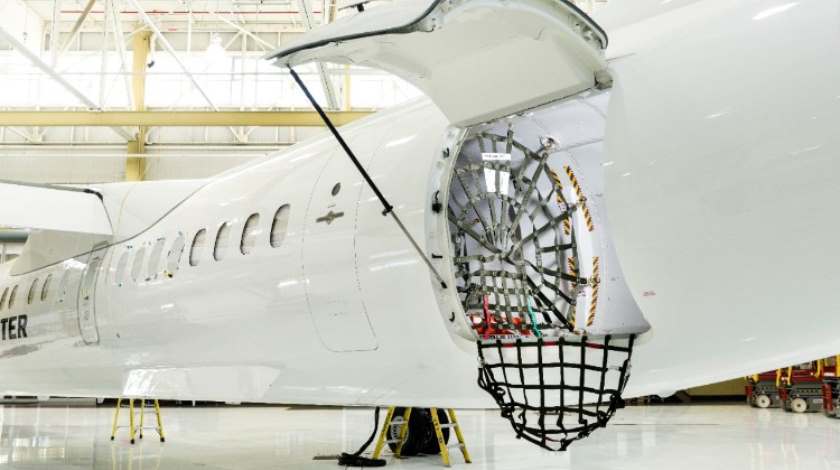Photo: Bombardier press release
Reading Time: 3 minutesBombardier Commercial Aircraft celebrated today with Ryukyu Air Commuter Co., Ltd (RAC) of Okinawa, Japan as the airline unveiled two of its Q400 Cargo-Combi aircraft during a special ceremony held at the Japan Transocean Air Maintenance Center at Naha Airport, Okinawa. RAC, the launch customer of the Q400 Cargo-Combi aircraft, is a member of Japan Airlines Group (JAL) and the Q400 aircraft unveiled today are the first two of five ordered by the airline in the cargo-passenger combi configuration.
RAC’s Q400 combi aircraft each provide up to 5,600 lb. (2,540 kg) of cargo capacity and comfortably accommodates 50 passengers. Inaugural tours of the aircraft were provided for guests that included representatives of the Okinawa prefectural government.
The airline, which also operates four Bombardier Q100 and one Q300 aircraft, provides domestic passenger services from the islands of Okinawa.
“Since 1997, RAC has been a strong champion of the Bombardier Dash 8 Series 100 aircraft that has served as the backbone of our regional network operations,” said Takashi Irei, President, Ryukyu Air Commuter. “As we approach 20 years of profitable and efficient operations, we are proud to grow our fleet and be the first airline to launch service with the Q400 Cargo-Combi aircraft. Today marks an important milestone in our continued collaboration with Bombardier and sets the stage for the next chapter of our growth strategy serving Okinawa’s business and leisure hubs.”
“It is an honor to celebrate the official unveiling of the Q400 Cargo-Combi aircraft right here in RAC’s backyard,” said Andy Solem, Vice President, Sales, China and North Asia, Bombardier Commercial Aircraft. “RAC — with its forward-thinking and innovative insight – sought Bombardier’s help to address a particular business requirement, and the unique Q400 Cargo-Combi aircraft is the result of that collaboration. The aircraft now offers new opportunities in the regional aircraft market for cargo-passenger transportation.”
About the Q400 Aircraft
Designed as a modern, 21st-century turboprop, the Q400 aircraft is the most recent development in the Q Series family of aircraft. It provides unmatched performance, operational flexibility and passenger comfort. In addition to the standard single-class configuration, Q400 aircraft are available with an optional dual-class interior for enhanced passenger comfort; in an optional extra-capacity configuration offering up to 90 seats for higher-density markets; and in a Cargo-Combi configuration.

The Q400 combi aircraft offers the greatest payload capability and operational flexibility in its segment, and is the only commercial turboprop available today offering various configurations. In the layout that provides the highest payload capability, the aircraft offers up to 9,000 lb. (4,082 kg) of cargo capacity and up to 1,150 cubic feet (32 cubic metres) of cargo volume. In this high-cargo version, the aircraft can comfortably accommodate 50 passengers at 32-inch seat pitch, and 58 at 29-inch seat pitch. The Q400 combi aircraft’s “Class C” cargo compartments are designed to meet the industry’s latest regulations.

Thanks to its combination of turboprop attributes, jet-like features, industry-leading passenger experience and environmental footprint, the Q400 aircraft is exceptionally versatile and can be adapted to a variety of business models. By offering a 30 per cent reduction in fuel burn over the jets it often replaces, the Q400 aircraft radically reduces carbon emissions and increases cost efficiency. Its high-speed cruise — 160 km/h faster than conventional turboprops — places the aircraft’s flight time within minutes of jet schedules, at the same seat cost as larger single-aisle jets. Its large propellers operate at a lower RPM, generating more power with less noise and making it a friendly option for city centres.
Compared to competing turboprops, Bombardier’s recently launched 90-seat Q400 aircraft – the world’s highest-capacity commercial turboprop — offers an additional 12 to 14 seats, 20 per cent cash operating cost advantage per seat, over 30 per cent higher speed, and delivers over $8 million US additional value per aircraft. As a confirmation of Bombardier’s focus on continuous improvement aimed at addressing traffic growth and enhancing customers’ bottom lines, Bombardier also announced a 2,000 lb-increase in the Q400 aircraft’s payload and an escalation of the A-Check and C-Check maintenance intervals from 600/6,000 to 800/8,000 flight hours* that are all available for entry-into-service as early as 2018.
The Q400 aircraft family includes over 60 owners and operators in almost 40 countries. The worldwide fleet has logged more than 6.7 million flight hours and has transported more than 413 million passengers. Long recognized as a high-value asset by operators, the Q400 aircraft is now also attracting growing interest from the leasing community.
Bombardier has recorded firm orders for a total of 547 Q400 aircraft.

